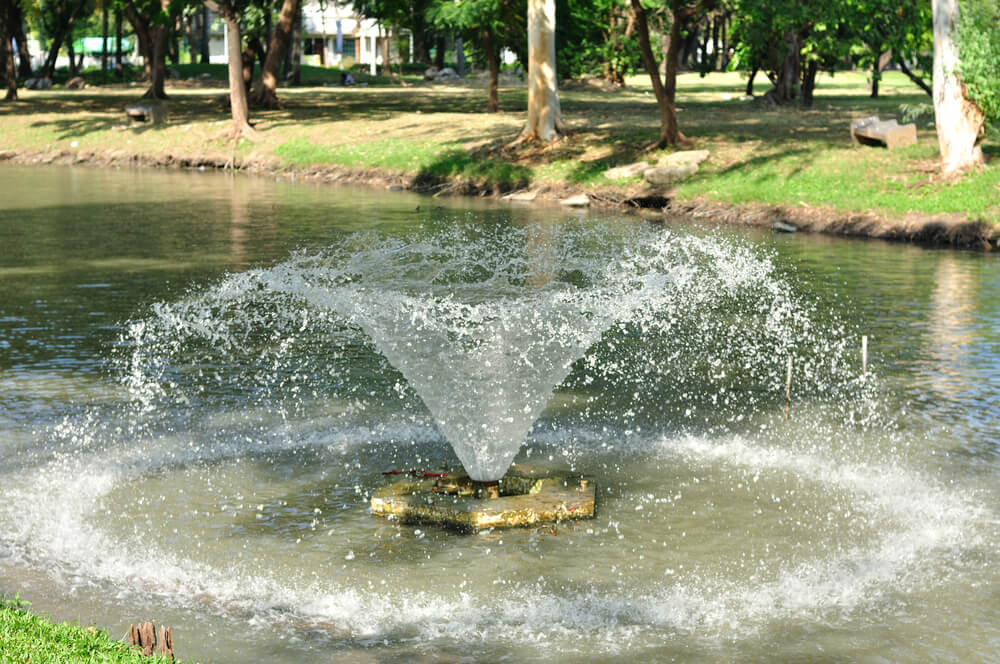There are many reasons why you would want to put a floating fountain in your lake or pond. They are not only aesthetically pleasing; they also help keep your pond or lake water healthy.
But how do you go about putting one in, and how do you maintain it? This article will help you with all the ins and outs.
Benefits of a Pond or Lake Fountain
First, let’s establish why you want a fountain in the pond or lake on your residential or business property. Everyone knows that they are beautiful and can create soothing sounds that promote relaxation and joy while being around the water.
Movement on the surface of the water also inhibits the bug population, thus creating a much more enjoyable space to spend time.
Fountains can also keep your water from smelling foul, as they move the top layer of water to the bottom and prevent odor-causing gasses from collecting at the bottom of the pond.
Fountains are also essential to keeping a healthy body of water. Fountains provide movement and aeration, allowing more oxygen into the water which prevents excessive bacteria growth that can harm the air, the water, and the environment.
If you have fish in your pond or lake, the extra aeration also creates more oxygen for the fish and makes it easier for them to process their food. Healthy fish contribute to healthy water quality, and healthy water quality creates healthy fish.
Choices for Pond Fountains
Your fountain can either be decorative or aerating. Decorative fountains usually range in size from a few feet high (good for a small residential pond) to a powerful 20+ feet height.
Fountains on the larger end often have the option to include patterned jets or nozzles that can put on a type of show (reminiscent of the famous Las Vegas Bellagio fountains).
You could also choose to insert a decorative pond aerator. This is the best of both worlds.
A decorative pond aerator will move the most amount of water possible with a heavy-duty propellor (similar to a motorboat, made of stainless steel).
No water will enter into the motor, which means there aren’t any pumps or nozzles that get clogged and you don’t have to worry about anything getting stuck in small pipes.
Decorative pond aerators throw up quite a bit of water in addition to moving that water and oxygen through the pond, so you still get that “wow” effect.
Options for Decorative Spray Patterns
If you want a simple decorative fountain, you will be able to choose among many types of spray patterns.
Remember that a traditional V-shaped pattern is the most efficient; if you go for a fancier spray (like one of these detailed below) then there will be less “energy” devoted to pond aeration.
- Crystalline Pattern – Crystalline fountains spray water in the shape of a diamond.
- Crown and Geyser Pattern – These fountains emit a large, high spray which is then surrounded by smaller, lower sprays of water, giving a crown-like effect
- Plume Pattern – Think of a large bird’s feather, like an ostrich or a peacock. These fountains give off a large funnel with a wide spray.
- Plum Tree Pattern – A plum tree fountain emits a narrow, round spray, resembling a tree as the water rises and falls.
Although a traditional decorative fountain gives some of the above-mentioned benefits just by its nature of moving water on the surface of the pond or lake, if you are looking for serious aeration for a large body of water, a functional aerating fountain will be your best choice.
These provide a large gallon-per-minute (GPM) turnover rate, which means a higher volume of movement throughout your pond or lake.
These are some considerations you should make when choosing an aerating fountain:
- Depth – If your pond or lake is over six feet deep, you might need a different system. Bodies of water under six feet take well to being aerated by a fountain.
- Shape – A standard aerating fountain can help move water and oxygen around a traditional round pond or lake. If the body of water is irregularly shaped, it will be difficult to reach all edges or areas.
- Size – Size is a determinant of the necessary spray height. The height of the fountain spray should be half the diameter of the pond or lake; otherwise, too much water will exit with the spray.
- Horsepower - Obviously, the larger a body of water, the more power will be needed to aerate it. If the fountain is your main source of aerating the pond or lake, you will need about 1.5hp for every acre of water.
Add an Aerating Fountain for Aesthetic Improvement and a Healthy Environment
Hopefully, when you obtained the property with a pond or lake or had one built into the land, you were told about the benefits of having a fountain.
If there is not one already installed, now you know why you should put one in.
If your fountain is old or isn’t up to the task of adequately aerating your pond or lake, now you know what questions to ask and the qualities to look for when you replace it.
Adding a decorative and/or aerating fountain will give your pond or lake an enjoyable atmosphere that is less likely to be errant with bugs, foul odors, and harmful algae.
It will also keep the water quality healthy and prevent gas emissions from ruining your water.
Plus, you can’t beat the visual or sound appeal of a fountain of water spraying beautifully right where you can enjoy it.
